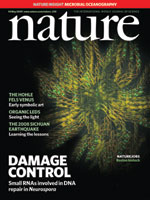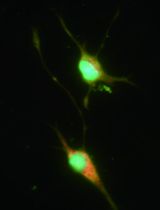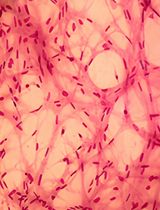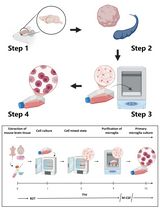- EN - English
- CN - 中文
Isolation and 3-dimensional Culture of Primary Murine Intestinal Epithelial Cells
原代鼠小肠上皮细胞的分离和三维培养
发布: 2014年05月20日第4卷第10期 DOI: 10.21769/BioProtoc.1125 浏览次数: 26533
Abstract
The intestine, together with skin and blood, belongs to the organs with the highest cell turnover, which makes it a perfect model to study cellular processes, such as proliferation and differentiation. Epithelial cell turnover in intestine is possible due to the presence of intestinal stem cells, which are located at the bottom of the crypt. Here, we recapitulate a detailed protocol for the isolation and culture procedures of primary epithelial intestinal cells in a three - dimensional (3D) in vitro system, described for the first time by Hans Clevers group (Sato et al., 2009). This specific 3D culture preserves intestinal stem cells, which give rise to differentiated progeny for example goblet cells. The culture has many applications and represents a useful model to study stem cell biology, epithelial cell regeneration, and transplantation studies. Moreover, the presented 3D culture can be used to investigate the barrier function of intestinal epithelial cells, as well as heterotypic cell interactions between epithelial cells and stromal cells.
Keywords: Intestinal epithelium (肠上皮细胞)Materials and Reagents
- Mouse (4 weeks-16 weeks old)
- Advanced DMEM/F12 (Life Technologies, Gibco®, catalog number: 12634-010 )
- Heat Inactivated Fetal Bovine Serum (FBS) (Life Technologies, Gibco®, catalog number: 10500-064 )
- PBS without Ca2+ and Mg2+ (Life Technologies, Gibco®, catalog number: 14190-094 )
- Penicillin/Streptomycin (10,000 Units/ml Penicillin; 10,000 µg/ml Streptomycin) (Life Technologies, Gibco®, catalog number: 15140-22 )
- 70% ethanol
- 100x GlutaMAXTM-I (Life Technologies, Gibco®, catalog number: 35050-038 )
- 1 M HEPES (Life Technologies, Gibco®, catalog number: 15630-080 )
- 50x B-27 Supplement (Life Technologies, Gibco®, catalog number: 17504-044 )
- 100x N-2 Supplement (Life Technologies, Gibco®, catalog number: 17502-048 )
- BD Matrigel Basement Membrane Matrix (10 ml) (BD Biosciences, catalog number: 354234 )
- Gentamicin Reagent Solution (50 mg/ml) (Life Technologies, catalog number: 15750-060 )
- Sterile 0.1% BSA (in PBS)
- Sterile 2 mM EDTA (see Recipes)
- Washing solution (see Recipes)
- N-Acetyl-L-cysteine (Sigma-Aldrich, catalog number: A9165-5G ) (see Recipes)
- Recombinant Murine EGF (Pepro Tech, catalog number: AF-315-09 ) (see Recipes)
- Recombinant Murine Noggin (Pepro Tech, catalog number: 250-38 ) (see Recipes)
- Recombinant Human R-Spondin-1 (Pepro Tech, catalog number: 120-38 ) (see Recipes)
Equipment
- Forceps and short, sharp-point scissors (e.g. Hardened Fine Iris Scissors, Fine Science Tools, catalog number: 14090-09 )
- 70 µm cell strainer (BD Biosciences, Falcon®, catalog number: 352350 )
- Centrifuge 5702R (Eppendorf)
- Cover glass
- Microscope
- 24-well tissue culture plate (Sarstedt AG, catalog number: 83.1836 )
- Petri dishes
- Falcon tubes (50 ml, 15 ml)
- Pipettes (20 ml, 10 ml, 1 ml, 100 µl)
- Pipetboy
- 37 °C, 5% CO2 cell culture incubator
Procedure
文章信息
版权信息
© 2014 The Authors; exclusive licensee Bio-protocol LLC.
如何引用
Pastuła, A. and Quante, M. (2014). Isolation and 3-dimensional Culture of Primary Murine Intestinal Epithelial Cells. Bio-protocol 4(10): e1125. DOI: 10.21769/BioProtoc.1125.
分类
细胞生物学 > 细胞分离和培养 > 3D细胞培养
干细胞 > 成体干细胞 > 上皮干细胞
细胞生物学 > 细胞分离和培养 > 细胞分离
您对这篇实验方法有问题吗?
在此处发布您的问题,我们将邀请本文作者来回答。同时,我们会将您的问题发布到Bio-protocol Exchange,以便寻求社区成员的帮助。
Share
Bluesky
X
Copy link













